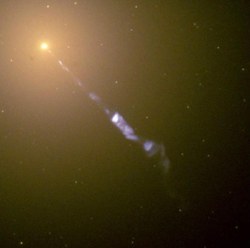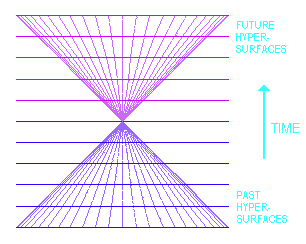
The most beautiful experience we can have is the mysterious.
It is the fundamental emotion that stands at the cradle of true art and true science.
Albert Einstein


When astronomers spot a new supernova in the Andromeda Galaxy, our nearest galactic neighbor, they know they are seeing an event which actually happened more than 2 million years ago. This, of course, is because the light from the supernova took that long to travel through space. Although light travels very fast, about 186,000 miles per second, it does not travel instantaneously. This means that the farther into space we look, the farther back in time we are seeing, and it also means that space and time are unavoidably interwoven into a single continuum known as spacetime.
Looking deeper and deeper into space, we find that the realm of the galaxy gradually gives way to the realm of the quasar, a mysterious object with the mass and energy of an entire galaxy, and in most cases, many times the energy of our own galaxy, concentrated into a relativity small spherical volume, like about the size of our solar system. Recent observations indicate that many quasars actually reside within host galaxies, and are most certainly powered by black holes.

As we gaze into the blackness of infinity itself, we are actually looking at the beginning of the Universe. The diverging field of infinity all around us, the experience of infinity, is like a reversed image of the Universal Singularity, the Big Bang. This popular name is an unfortunate one, and it was coined by cosmologists who did not support the idea (which was most of them early on). Most importantly, the cosmic creation event was nothing like an explosion at all, but more like the intense force field experienced near the singularity of a super-massive black hole.
In fact, the conditions in the earliest stages of the Universe would be very similar to the conditions we would find right now deep within any atom, in the quantum realm. We all know that the bodies we find ourselves living in are made of countless atoms forged eons ago in the nuclear furnaces of the stars. In much the same way, these atoms are composed of the primordial quantum processes born in the first stages of the Big Bang itself. The entire history of the Universe is encoded into the most basic components of our bodies, so as strange as it may seem, we are actually not far removed from the beginning of the Universe even at this very moment.

Einstein found that the speed of light was not only finite, but also must be a constant, regardless of the motion of any observer. Since the present state of the Universe for an observer is defined by light coming from objects, and other observers have other light coming to them over a different path through spacetime, a very strange condition is imposed -- any objective view of the Universe must be entirely observer-dependent.
Every one of us has our very own light-cone which defines for us the present state of the Universe, along with what we experience as the passage of time. Everyone's light-cone is unique, so no one can ever precisely agree on what is happening where or when. Of course, the differences are negligible except under relativistic conditions, such as near the speed of light or the singularity of a black hole, but they are real and they are there, all the time. In fact, since everything we see in space, from our own bodies to the distant quasars, are images from the past, the actual present state of the Universe is never seen. In doing the work of science, the physicist must make a clear distinction between 'that which actually is' and 'that which only appears to be'. Disturbingly, everything seems to fall into the latter category.
Special Relativity

The observer's light-cone is represented geometrically by a spacetime diagram, called a Minkowski diagram after the developer of the concept of the four-dimensional spacetime continuum. This is the foundation of Special Relativity. It makes clear that any observation or measurement must be done with particular attention to the relationship between reference frames -- objective spacetime is relative.
It is called Special Relativity because, as an initial formulation, it only included non-inertial reference frames, that is, reference frames that are not accelerating with respect to each other. General Relativity, on the other hand, does include accelerating reference frames and turns out to be a geometric theory of gravity. What is most important for our purposes is to note that both Special and General Relativity are rooted in the geometry of spacetime.
In order to include the fourth dimension of time in the spacetime diagram, one of the space dimensions must be dropped from the three-dimensional picture. This is done by representing all of three-dimensional space as a two-dimensional plane, so that the passage of time can be represented by the movement of that plane through what used to be the other space dimension.

This plane of three-dimensional space is called a hypersurface. It represents all of space at any given moment in universal time, a universal simultaneity. This is not the simultaneity experienced by an individual observer. What we see in space at any instant in time is entirely contained on the surface of our past light-cone, which is a mere singularity on the hypersurface of the present. Even our bodies are on our past light-cone, inside and out. Different observers are different singularities on the hypersurface of the present, each with a distinct light cone and a unique perspective on the field of spacetime. The actual hypersurface of the present is nonobjective -- it is never seen.
As we look into space, we are observing our past light-cone slicing concentric rings through the hypersurfaces of the past, each of which had previously been a hypersurface of the present. Each ring on the past light-cone represents a spherical plane in 3-D space centered on the observer. The largest ring at the base of the past light-cone represents what we see as the blackness of infinity, which is essentially a reversed image of the Big Bang itself.
The future light-cone represents the region of spacetime that the observer can influence through normal causality. Movement of the physical body or any material thing is limited to the region of wherewhens within the cone, and to reach any spacetime position on the surface of the future light-cone would require movement at the speed of light.
Keep in mind that the hypersurface of the present and the light-cones are dynamic -- they change continuously. As time passes, the hypersurface of the present and the light-cones
'advance', so that what had been the current past light-cone a second ago is now a cone
For most of this century, science has been struggling with some very strange revelations brought to light by Relativity and quantum physics. These insights have shown us that the basic ideas we have always taken for granted about objective reality are very limited views of what the Universe must really be like. The reason they were such a struggle for science is that they blew away the foundational framework of classical physics along with our entire understanding of physical reality in a most fundamental and definite way. Could it be that our natural assumptions about space and time are simply not correct? Perhaps we have yet to realize the most beautifully mysterious experience of all.
Then the son of Pandu beheld the entire Universe,
in all its multitudinous diversity,
lodged as one being within the body of the God of gods.
Bhagavad Gita



